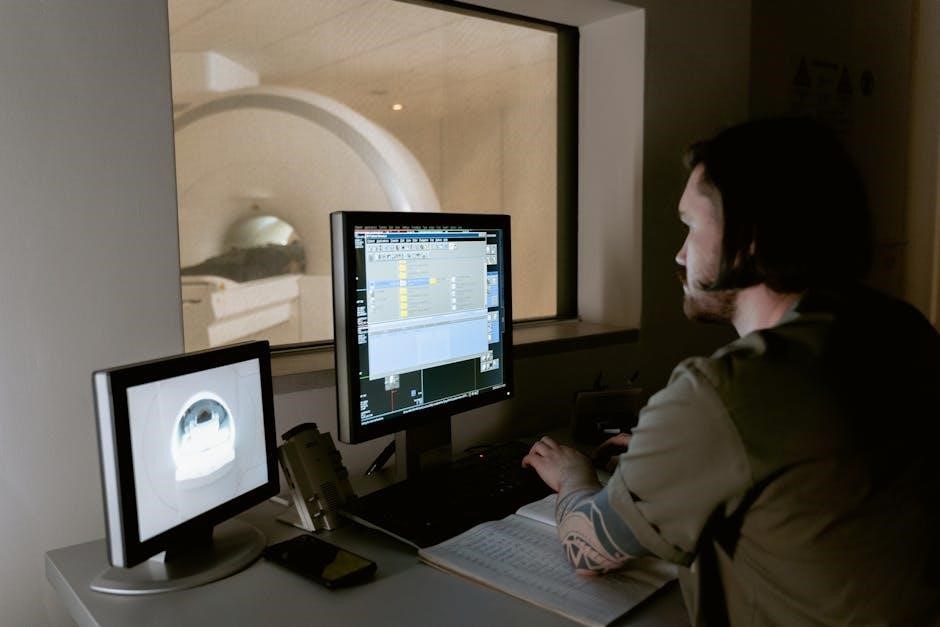The Common Admission Test (CAT) is a computer-based exam for MBA admissions in India, assessing Quantitative Ability, Verbal Ability, and Logical Reasoning & Data Interpretation skills.

Exam Structure
The CAT exam is conducted in three sessions: 8:30 AM, 12:30 PM, and 4:30 PM, each lasting two hours. It is a computer-based test evaluating candidates’ aptitude in specific sections.
Sections of the CAT Exam
The CAT exam is divided into three primary sections: Quantitative Ability (QA), Verbal Ability and Reading Comprehension (VARC), and Logical Reasoning and Data Interpretation (LRDI). Each section evaluates distinct skills critical for management education. The QA section tests mathematical aptitude, covering topics like arithmetic, algebra, and geometry. VARC assesses language skills, including reading comprehension, grammar, and vocabulary. LRDI focuses on analytical and problem-solving abilities through logical puzzles and data interpretation questions. Together, these sections provide a comprehensive assessment of a candidate’s aptitude for MBA programs. The exam’s structure ensures a balanced evaluation of quantitative, verbal, and logical reasoning skills, making it a robust tool for selecting candidates for top-tier business schools. Understanding these sections is essential for effective preparation and strategy development.
Types of Questions
The CAT exam features a mix of question types designed to test various cognitive skills. The primary types include Multiple Choice Questions (MCQs) and Non-MCQs. MCQs provide multiple answer options, while Non-MCQs require direct answers, often numerical or textual. The Verbal Ability section includes Reading Comprehension passages followed by questions, while Logical Reasoning puzzles test analytical thinking. Data Interpretation questions present charts or tables, requiring candidates to analyze and compute data. Quantitative Ability questions cover arithmetic, algebra, and geometry, often in both MCQ and Non-MCQ formats. The exam also includes True/False questions and Fill-in-the-Blanks for Verbal Ability. Each question type is designed to assess problem-solving, critical thinking, and time management skills. Understanding these question types is crucial for effective preparation and strategy development. The CAT exam’s diverse question types ensure a comprehensive evaluation of a candidate’s abilities.
Eligibility Criteria
To be eligible for the Common Admission Test (CAT), candidates must hold a bachelor’s degree in any discipline from a recognized university. They must secure at least 50% marks (or equivalent CGPA) in their undergraduate program. For candidates belonging to SC, ST, and PWD (Divyangjan) categories, a relaxation of 5% is provided. Final-year students are also eligible to apply, provided they complete their degree by June 30, 2025. Additionally, candidates with professional certifications like CA, CS, or ICWA are eligible. There is no upper age limit for appearing in CAT. Candidates must ensure they meet the eligibility criteria before applying, as any discrepancy may lead to disqualification. The eligibility criteria are strictly enforced by the conducting IIM to maintain the exam’s standards and fairness.

Application Process
The CAT application process begins with online registration, followed by filling the form, uploading documents, and paying fees. Candidates must provide valid email IDs and phone numbers for communication.
Registration Steps
The CAT registration process begins with visiting the official website, https://iimcat.ac.in. Candidates must create a unique profile by providing basic details like name, email, and phone number. Once registered, they can log in to fill the application form, which includes personal, academic, and work experience information. Uploading scanned documents such as photographs, signatures, and category certificates (if applicable) is mandatory. Payment of the application fee, typically around ₹2000, can be made online via credit/debit cards, net banking, or UPI. After submitting the form, candidates receive a confirmation message. It is essential to download and save the registration confirmation for future reference. The process is straightforward, but candidates must ensure all details are accurate to avoid rejection. The registration window usually opens in August and closes in September, with late fees applicable for delayed submissions. Timely completion is advised to secure a preferred exam slot.
The CAT application form requires detailed personal and academic information. Candidates must provide their name, date of birth, contact details, and permanent address. Academic details include SSC, HSC, and graduation marks, along with work experience if applicable. Uploading recent passport-sized photographs and signatures is mandatory, with specific format and size requirements. Candidates from reserved categories must upload valid certificates. The form also includes a section for selecting exam cities and IIM preferences. Payment of the application fee, typically ₹2000, is done online. After submission, candidates receive a confirmation email. It is crucial to review all details before submission, as corrections are not allowed later. The form is available on the official CAT website, and candidates are advised to fill it carefully to avoid rejection. Proper documentation and adherence to guidelines ensure a smooth application process. Effective CAT preparation involves regular practice, mock tests, and focused study on weak areas. Utilize previous years’ papers and recommended materials to enhance problem-solving skills and time management. To excel in the Common Admission Test (CAT), a well-structured study plan is essential. Start by understanding the exam pattern and syllabus in detail. Focus on improving your core concepts in Quantitative Ability, Verbal Ability, and Logical Reasoning & Data Interpretation. Practice previous years’ question papers to familiarize yourself with the question types and timing. Regular mock tests will help assess your preparation level and identify weak areas. Dedicate time to solving puzzles, reading comprehension passages, and numerical problems daily; Stay updated with the latest exam notifications and trends. Join study groups or forums for shared learning and strategies. Consistent effort and the right approach will lead to success in the CAT exam. Preparing for the Common Admission Test (CAT) requires access to the right study materials. Previous years’ question papers and official mock tests are indispensable for understanding the exam pattern and improving time management. Additionally, aspirants can benefit from CAT preparation books such as Quantitative Ability for CAT by Arun Sharma, Verbal Ability and Reading Comprehension for CAT by Meenakshi Upadhyay, and Logical Reasoning and Data Interpretation for CAT by Nishit Sinha. Online resources like CAT official guides and study portals provide updated content and practice exercises. Mock test series from reputable coaching institutes also simulate real exam conditions, helping candidates refine their strategies. Using these materials effectively ensures a focused and result-oriented preparation journey for CAT aspirants. The Common Admission Test (CAT) follows a structured timeline for its exam cycle. For CAT 2024, the application process commenced on August 1, 2024, with the exam scheduled for November 24, 2024, in three sessions. The admit card was released on November 5, 2024, allowing candidates to access their hall tickets. The provisional answer key is set to be published on December 3, 2024, enabling candidates to challenge any discrepancies. Results are expected to be declared in the first week of January 2025. Candidates are advised to keep track of these dates to ensure timely completion of all steps, from registration to result verification. Staying updated with the official CAT website is crucial for aspirants to plan their preparation and application process effectively. The results of the Common Admission Test (CAT) are typically announced within a few weeks after the exam. For CAT 2024, the results were declared by the Indian Institute of Management (IIM) Calcutta, allowing candidates to access their scorecards online. The scorecard provides detailed scores for each section—Quantitative Ability, Verbal Ability, and Logical Reasoning & Data Interpretation—as well as overall percentile rankings. Candidates can download their scorecards by logging into the official CAT portal using their credentials. The scorecard is valid for one year and is essential for admission to MBA programs across participating institutes. It is important for candidates to verify their scores and ensure all details are accurate before proceeding with the admission process. The release of results marks a critical step in the MBA admission journey, enabling candidates to plan their next steps accordingly. The counseling process for the Common Admission Test (CAT) is a crucial step after the results are declared. It is conducted by the Indian Institute of Management (IIMs) and other participating institutes to allocate seats based on candidates’ scores and preferences. The process typically involves registration, document verification, and seat allocation. Candidates are required to provide their preferred colleges and programs during the counseling phase. The allocation is based on factors such as CAT scores, percentile rankings, and reservation criteria. Once the seat allocation is finalized, candidates are notified and must confirm their admission by paying the required fees. The counseling process ensures a fair and transparent admission system, allowing candidates to secure seats in top MBA programs across India. It is essential for candidates to follow the instructions carefully to avoid missing out on admission opportunities. The counseling schedule is usually announced after the results are published. Previous years’ papers of the Common Admission Test (CAT) are invaluable resources for candidates preparing for the exam. These papers provide insights into the exam pattern, question types, and difficulty levels. Candidates can download CAT question papers from 1991 to 2024 in PDF format, along with their answer keys and detailed solutions. Analyzing these papers helps aspirants identify recurring topics, understand time management strategies, and familiarize themselves with the computer-based test format. Additionally, solving previous years’ papers allows candidates to assess their performance, identify weak areas, and refine their problem-solving skills. Many educational platforms and websites offer these resources, making it easier for candidates to access and utilize them effectively. Regular practice with past papers is a proven strategy to improve scores and build confidence for the actual exam. While preparing for the Common Admission Test (CAT), candidates often make avoidable mistakes that can negatively impact their performance. One common error is poor time management during the exam, leading to incomplete sections. Many aspirants also neglect to practice all three sections equally, focusing overly on their strengths while ignoring weaknesses. Additionally, some candidates fail to attempt enough mock tests, which are crucial for familiarizing oneself with the exam format and improving speed. Another mistake is not thoroughly reviewing the exam pattern and syllabus, leading to surprises on test day. Lastly, some aspirants underestimate the importance of mental preparation and stress management, which are vital for maintaining focus during the exam. Avoiding these pitfalls can significantly enhance a candidate’s chances of scoring well in the CAT. Proper planning and consistent practice are key to success. Candidates often have several questions about the Common Admission Test (CAT). One common query is about the exam pattern and syllabus, which includes sections like Quantitative Ability, Verbal Ability, and Logical Reasoning & Data Interpretation. Another frequently asked question is about the eligibility criteria, which requires a bachelor’s degree with at least 50% marks. Many aspirants also inquire about the application process, including registration steps and form details. Additionally, candidates often ask about the scoring system, including the use of sectional and overall cutoffs. Some also seek clarification on the exam dates and timing, as well as the availability of previous years’ question papers for practice. Lastly, there are questions about the role of CAT in MBA admissions and how scores are used by IIMs and other B-schools. Addressing these FAQs helps candidates prepare more effectively for the exam. The Common Admission Test (CAT) is expected to evolve with advancements in technology and changing educational demands. Future trends may include the integration of artificial intelligence (AI) for personalized assessments, ensuring a more adaptive testing experience. There could also be a greater emphasis on real-world case studies and industry-relevant questions to better align with modern business scenarios. Additionally, the exam might incorporate more interactive elements, such as virtual simulations, to test problem-solving skills in dynamic environments. Environmental and social governance (ESG) topics could gain prominence, reflecting their growing importance in business education. Furthermore, the exam process might become more accessible, with AI-driven tools to assist differently-abled candidates. These innovations aim to enhance the exam’s effectiveness in identifying top talent for MBA programs while keeping pace with global trends in education and technology. The Common Admission Test (CAT) remains a pivotal gateway for aspirants seeking admission to prestigious MBA programs in India. As a rigorous assessment of Quantitative Ability, Verbal Ability, and Logical Reasoning & Data Interpretation, CAT plays a crucial role in shaping the future of management education. Its computer-based format ensures a standardized evaluation process, making it a fair and reliable tool for identifying top talent. Over the years, CAT has evolved to align with industry demands, incorporating advancements in technology and testing methodologies. For candidates, preparing for CAT not only enhances their academic skills but also builds resilience and strategic thinking. As the exam continues to adapt to global trends, it remains a cornerstone for aspiring business leaders, offering a pathway to esteemed institutions and unlocking opportunities for professional growth. Several resources are available to aid CAT preparation, including downloadable PDFs of previous years’ question papers, answer keys, and detailed solutions from 1991 to 2024. These materials provide valuable insights into exam patterns and help candidates practice effectively. Additionally, online platforms offer study guides, mock tests, and video tutorials to enhance preparation. Candidates can also access English dictionaries and integrated thesauruses to improve their Verbal Ability skills. Furthermore, official CAT websites and portals provide updates on admit cards, hall tickets, and exam-related notifications. Utilizing these resources strategically can significantly boost a candidate’s readiness for the exam. Ensuring access to these materials is essential for a well-rounded and informed preparation strategy. The CAT scoring system evaluates candidates based on their performance in three sections: Quantitative Ability, Verbal Ability, and Logical Reasoning & Data Interpretation. Each section is scored separately, with the total marks varying annually. Correct answers typically award 3 marks, while incorrect attempts deduct 1 mark. Unattempted questions do not affect the score. The overall percentile is calculated relative to the performance of all test-takers, making it a competitive measure. Additionally, the scoring system includes a normalization process to ensure fairness across different exam sessions. Candidates can download their scorecards, which detail section-wise and overall scores, after the results are announced. Understanding the scoring system is crucial for interpreting performance and planning future attempts. It also helps candidates identify areas for improvement, ensuring a more focused preparation strategy. The scoring system remains consistent, providing a clear framework for evaluation. On CAT exam day, ensure you are well-prepared to perform at your best. Start with a good night’s sleep and a nutritious meal to maintain energy levels. Reach the test center early to avoid last-minute stress. Carry essential documents like your admit card and a valid ID. Familiarize yourself with the computer setup before the exam begins. Skim through the instructions again, even if you’ve practiced them. Allocate your time wisely, focusing on your strongest sections first. Stay calm and composed; deep breathing can help manage anxiety. Read each question carefully to avoid mistakes. Attempt questions you’re confident about first to secure marks. Avoid spending too much time on a single question. If time permits, review your answers to ensure no questions are left unattempted. Stay focused and give your best effort to achieve a high score. Proper time management and a clear mind are key to success. Good luck! The Common Admission Test (CAT) plays a pivotal role in MBA admissions in India, serving as a standardized benchmark for evaluating candidates. It is the primary entrance exam for top-tier business schools, including the Indian Institutes of Management (IIMs). CAT scores are used to shortlist candidates for further rounds such as group discussions, personal interviews, and written ability tests. The exam assesses key skills like Quantitative Ability, Verbal Ability, and Logical Reasoning & Data Interpretation, which are essential for success in management programs. A high CAT score significantly enhances a candidate’s chances of securing admission to prestigious MBA institutions. Additionally, many non-IIM colleges and universities also consider CAT scores for their MBA/PGDM programs, making it a critical component of the MBA admission process in India. Thus, CAT is not just an exam but a gateway to shaping the future of aspiring business leaders. Its importance cannot be overstated.Application Form Details
Preparation Strategies
Effective Preparation Tips
Recommended Study Materials

Important Dates

Results and Scorecards

Counseling Process
Previous Years’ Papers

Common Mistakes to Avoid

Frequently Asked Questions

Future Trends in CAT
Additional Resources
Understanding the Scoring System

Exam Day Tips
Role of CAT in MBA Admissions


